|
 Chalciporus piperatus Chalciporus piperatus
SynonymsSuillus piperatus
Boletus piperatus
BiostatusPresent in region - Exotic
Images (click to enlarge)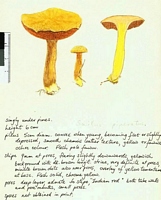
Caption: Watercolour
Owner: G.M. Taylor | 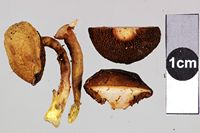
Owner: J.A. Cooper | 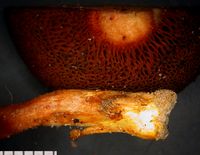
Owner: J.A. Cooper | 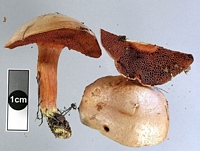
Owner: J.A. Cooper | 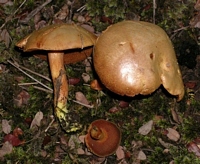
Owner: J.A. Cooper | 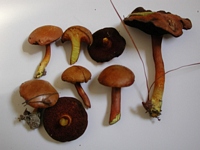
Caption: fruitbody
Owner: J.A. Cooper | 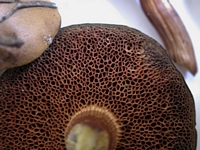
Caption: fruitbody
Owner: J.A. Cooper | 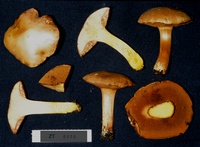
Caption: ZT8448
Owner: E. Horak: © Creative Commons Attribution-Noncommercial 3.0 New Zealand | 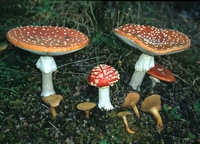
Caption: ZT8761
Owner: E. Horak: © Creative Commons Attribution-Noncommercial 3.0 New Zealand | 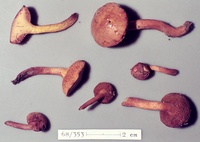
Caption: ZT68-353
Owner: E. Horak: © Creative Commons Attribution-Noncommercial 3.0 New Zealand | 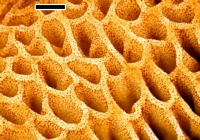
Caption: scale = 0.5mm. Close up of pores showing cystidia.
Owner: J.A. Cooper | 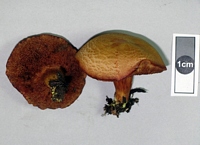
Owner: J.A. Cooper | 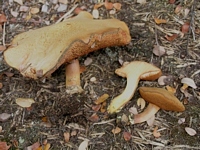
Owner: J.A. Cooper | 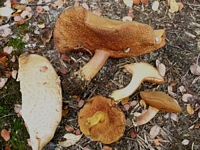
Owner: J.A. Cooper | 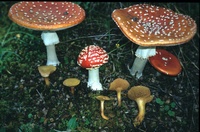
Caption: ZT8761
Owner: E. Horak: © Creative Commons Attribution-Noncommercial 3.0 New Zealand | 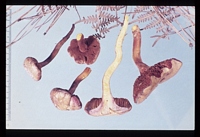
Caption: C-4128
Owner: Herb. PDD | 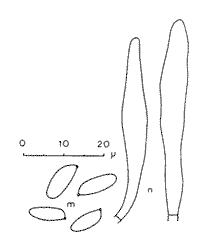
Caption: Fig. 2 - m, n, Suillus piperatus: m, spores; n, cystidia |
Article: Stevenson, G. (1962) [1961]. The Agaricales of New Zealand: I. Kew Bulletin 15(3): 381–385.
Description: Pileus 4-7 cm. slightly glutinous at first, fawn to light brown, smooth; flesh with a strong peppery taste. Pores about 0.5 mm. diam., dull brown to dark red. Stipe 1-1.5 X 5-8 cm., smooth or indistinctly striate, pale fawn to darker fawn at base; flesh of stipe bright yellow at base, usually attached to yellow rhizomorphs. Spores 8-9 X 3-4um.
Habitat: associated with Pinus in the Kaingaroa Forest.
Article: McNabb, R.F.R. (1968). The Boletaceae of New Zealand. New Zealand Journal of Botany 6(2): 137-176 (http://www.rsnz.org/publish/abstracts.php).
Description: PILEUS: convex
to plano-convex, 2-6 cm diam., slightly mucilaginous under wet conditions, otherwise
dry, glabrous to subglabrous, brownish orange, yellowish brown, or cinnamon
brown; cuticle a thin and rather fragmentary trichodermium overlying interwoven,
repent, gelatinised hyphae; margin entire. HYMENOPHORE: tubes to 6mm long, adnate
to subdecurrent, yellowish brown to reddish brown at maturity; pores concolorous
with tubes or darker reddish brown angular to irregularly angular, often radially
elongated near apex of stipe, 0.5-1 mm diam., often toothed. STIPE: 2.5-6 cm
long, more or less equal, 3-7 mm diam., solid, dry, subpruinose to subglabrous,
sometimes finely reticulate apically, concolorous with or paler than pileus,
golden yellow basally; glandulae absent; flesh yellow, often with red tints
apically; basal mycelium golden yellow; annulus absent.
SPORES: spore print
brown (between Prout's Brown and Snuff Brown); spores melleous, elliptic-subfusiform,
7.7-10.5-(14) X 3.1-4.2-(4.8) µm, smooth. HYMENIUM: basidia hyaline, clavate
18-27 X 6-9.5 µm., 4-spored; cystidia sparse, hyaline or encrusted with brown,
resinous material, subclavate to ventricose-rostrate, occasionally strangulated,
30-60 X 4.5-7.5 µm. HYMENOPHORAL TRAMA: bilateral, of the Boletus subtype; clamp
connections absent. CONTEXT OF PILEUS: sordid white to sordid cream, usually
with red tints, unchanging on exposure to air. TASTE: acrid, peppery. SMELL:
not distinctive. CHEMICAL REACTIONS: KOH and NH4OH on pileus and context of
pileus—no definite or constant reaction.
Habitat: HABITAT: Gregarious or occasionally caespitose under
introduced conifers.
Notes: Suillus piperatus is an introduced species indigenous to temperate regions of the northern
hemisphere. Of the two commonly recognised varieties of this species, var. piperatus
and var. amarellus (Quel.) Singer, New Zealand collections agree with
the type variety. The possession of a reddish hymenophore is an unusual character
among the Suilli. This character, together with the absence of both glandulae
and an annulus, led Singer (1938) to erect the section Piperati to accommodate
Suillus piperatus. Two further species were later transferred to this
section by Singer. Smith and Thiers (1964) excluded sect. Piperati from
Suillus on the grounds of a number of features correlated with the reddish
hymenophore, but did not suggest an alternative disposition of the section.
Suillus piperatus also differs physiologically from other Suillus. Tyler, Benedict, and
Stuntz (1965) showed that of the 17 species of Boletaceae tested for urea accumulation,
including nine species of Suillus, only S. piperatus showed a
moderate level of urea; the remainder were urea-negative. It would be of interest
to see whether tests on S. rubinus (W. G. Smith) O. Kuntze and S.
rubinellus (Peck) Singer, the remaining two species included in sect. Piperati
by Singer (1962), produced similar results.
It has been shown
in Europe and North America that S. piperatus is capable of forming mycorrhizal
associations in nature with many genera of conifers as well as angiosperm genera
such as Fagus, Quercus, Betula, and Populus. In
New Zealand, the species has been collected only under introduced conifers.
Rawlings (1951) recorded its association with Pinus contorta var. latifolia
and P. ponderosa, in addition to the two species named above.
The peppery taste
of Suillus piperatus makes it unsuitable for eating in quantity. However,
it is not a poisonous species and may be added in small quantities to other
edible species to sharpen the flavour.
S. piperatus is characterised by the dry to slightly mucilaginous pileus, reddish hymenophore,
absence of glandulae and an annulus, and small fruitbodies. Was first recorded
from New Zealand by Rawlings (1951).
Article: Gadgil, P.D. (in association with Dick, M.A.; Hood, I.A.; Pennycook, S.R.) (2005). Fungi on trees and shrubs in New Zealand. Fungi of New Zealand. Ngā Harore o Aotearoa 4: xi + 437 p. Hong Kong: Fungal Diversity Press.
Description: Type: Mycorrhizal Fungi; Description: Basidiomata pileate. Pileus brownish orange to cinnamon brown, 20–60 mm in diameter, convex to plano-convex, slightly mucilaginous when wet; flesh dirty white with red tints. Pore surface adnate to subdecurrent; tubes yellowish brown to reddish brown, up to 6 mm long; pores angular, concolorous with tubes or darker reddish brown, 0.4–1 mm in diameter. Stipe more or less cylindrical, yellowish brown to pale reddish brown, golden yellow at base, annulus absent, pruinose to glabrous, 25–60 mm long. Basidiospores elliptical, 0-septate, 8–11 × 3–4 μm, smooth, yellowish.
Distribution: Distribution: Auckland, Bay of Plenty, Taupo, Nelson, Buller, North Canterbury, Mid Canterbury, Otago Lakes, Dunedin, Southland.; 1st Record: Rawlings (1951: as Boletus piperatus).
|